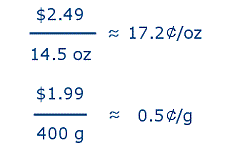When we come across a rate in an expression such as seventy beats
per minute (the average adult's normal resting heart rate), we will want to rewrite it as:

A similar example is the rainfall rate for Hilo, Hawai`i from the preceding section (example 4) where we determined the annual average to be approximately 130 inches per year. This may also be translated into a fraction of the form:
Technically, rates are ratios whose numerator and denominator possess different units (and thus are not pure numbers). At this moment. it's a detail which need not concern us. However, you may have already recognized that in both of these rates (above) the numerical portion of each denominator was "1." This precise format may not always be absolutely mandatory, although it is rather typical and we will usually write rates which we come across according to this standard convention.
Our first mathematical drill involving ratios will be to discuss an important rate sometimes better known as "unit price".
* * *

A similar example is the rainfall rate for Hilo, Hawai`i from the preceding section (example 4) where we determined the annual average to be approximately 130 inches per year. This may also be translated into a fraction of the form:

Technically, rates are ratios whose numerator and denominator possess different units (and thus are not pure numbers). At this moment. it's a detail which need not concern us. However, you may have already recognized that in both of these rates (above) the numerical portion of each denominator was "1." This precise format may not always be absolutely mandatory, although it is rather typical and we will usually write rates which we come across according to this standard convention.
Our first mathematical drill involving ratios will be to discuss an important rate sometimes better known as "unit price".
Unit pricing is a relatively straightforward affair once one becomes wholly aware that a product's unit price is simply a rate defined as cost per unit (of volume, weight, etc.). Thus, it will be the price paid for one gallon, one gram, etc. of some item. Keeping this in mind, let us now confront an easy foe — determining the unit prices for a couple of products in order to decide which is the more economical purchase.
|
|
|
Tostitos Tortilla Chips are advertised at a price of $2.49 for a 14½ oz bag while a 400 g bag
of Doritos Corn Chips sells for $1.99. Which is the better buy?
|
To find the "unit price,"
divide the cost by the
amount (in this case, either the number of ounces or the number
of grams) in order to obtain...

